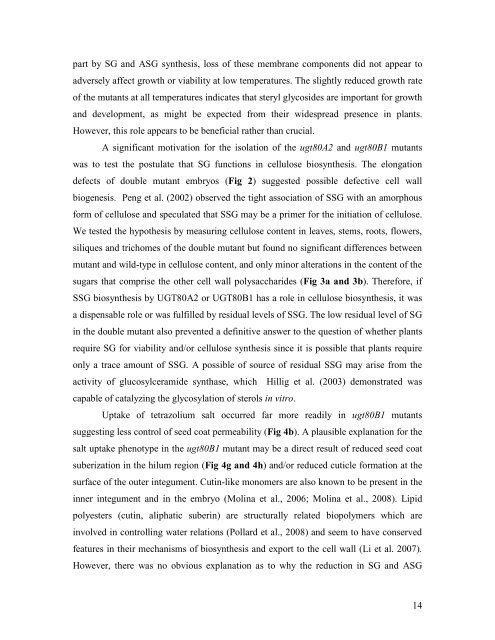1 Running head: Steryl glycoside mutants Name: Seth DeBolt ...
1 Running head: Steryl glycoside mutants Name: Seth DeBolt ...
1 Running head: Steryl glycoside mutants Name: Seth DeBolt ...
Create successful ePaper yourself
Turn your PDF publications into a flip-book with our unique Google optimized e-Paper software.
part by SG and ASG synthesis, loss of these membrane components did not appear to<br />
adversely affect growth or viability at low temperatures. The slightly reduced growth rate<br />
of the <strong>mutants</strong> at all temperatures indicates that steryl <strong>glycoside</strong>s are important for growth<br />
and development, as might be expected from their widespread presence in plants.<br />
However, this role appears to be beneficial rather than crucial.<br />
A significant motivation for the isolation of the ugt80A2 and ugt80B1 <strong>mutants</strong><br />
was to test the postulate that SG functions in cellulose biosynthesis. The elongation<br />
defects of double mutant embryos (Fig 2) suggested possible defective cell wall<br />
biogenesis. Peng et al. (2002) observed the tight association of SSG with an amorphous<br />
form of cellulose and speculated that SSG may be a primer for the initiation of cellulose.<br />
We tested the hypothesis by measuring cellulose content in leaves, stems, roots, flowers,<br />
siliques and trichomes of the double mutant but found no significant differences between<br />
mutant and wild-type in cellulose content, and only minor alterations in the content of the<br />
sugars that comprise the other cell wall polysaccharides (Fig 3a and 3b). Therefore, if<br />
SSG biosynthesis by UGT80A2 or UGT80B1 has a role in cellulose biosynthesis, it was<br />
a dispensable role or was fulfilled by residual levels of SSG. The low residual level of SG<br />
in the double mutant also prevented a definitive answer to the question of whether plants<br />
require SG for viability and/or cellulose synthesis since it is possible that plants require<br />
only a trace amount of SSG. A possible of source of residual SSG may arise from the<br />
activity of glucosylceramide synthase, which Hillig et al. (2003) demonstrated was<br />
capable of catalyzing the glycosylation of sterols in vitro.<br />
Uptake of tetrazolium salt occurred far more readily in ugt80B1 <strong>mutants</strong><br />
suggesting less control of seed coat permeability (Fig 4b). A plausible explanation for the<br />
salt uptake phenotype in the ugt80B1 mutant may be a direct result of reduced seed coat<br />
suberization in the hilum region (Fig 4g and 4h) and/or reduced cuticle formation at the<br />
surface of the outer integument. Cutin-like monomers are also known to be present in the<br />
inner integument and in the embryo (Molina et al., 2006; Molina et al., 2008). Lipid<br />
polyesters (cutin, aliphatic suberin) are structurally related biopolymers which are<br />
involved in controlling water relations (Pollard et al., 2008) and seem to have conserved<br />
features in their mechanisms of biosynthesis and export to the cell wall (Li et al. 2007).<br />
However, there was no obvious explanation as to why the reduction in SG and ASG<br />
14

















